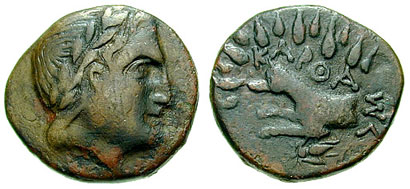A coin of the dog star from Karthaea, Keos
 |
| Coin of Karthaea, Keos, showing the Dog Star |
This coin of the month comes from Karthaea on the island of Keos in the Cyclades and dates to the 3rd century BC. On the obverse the head of Apollo is shown crowned with a laurel wreath. On the reverse a dog is depicted with rays emanating from its head, representing the Dog Star. The legend reads ΚΑΡΘΑΣΑ. The images depicted are associated with an ancient local cult that sacrificed to Zeus and to the Dog Star so that the Etesian winds might blow, bring cooler weather, and ward off disease.
The Dog Star is the brightest star in the night sky when it rises in late summer and it is traditionally associated with the Dog Days, when there is hot weather. Because of its brightness and its bluish hue, the star was believed to produce “emanations” which could bring on deadly epidemic diseases. Indeed, in ancient Greek thought as far back as Hesiod and Homer, the Dog Star was believed to have brought on diseases associated with the over-heating and drying of the body, such as fevers.
The cult on Keos is fascinating as it shows the inhabitants trying to guard against the effects of the Dog Star. Both Apollonius Rhodius and Callimachus describe the practices and rituals involved, as well as the mythology behind this cult. The story goes that the Dog Star was burning the Cyclades with its heat and producing much pestilence on the islands. The people of Keos prayed to the rural god Aristaios, the son of Apollo and Cyrene, who was taught both medicine and divination by the Centaur Chiron. Aristaios came to Keos and built a large altar to Zeus Ikmaios. He then offered sacrifices to Zeus and to the Dog Star from the mountaintops and Zeus, in response, sent the Etesian winds to cool the land for forty days.
Aristaios ordered the islanders to perform this rite every year so as to appease the violent rising of the Dog Star and to pray to Zeus for the Etesian winds. The scholia of the text describes how the islanders watched for the rising of the Dog Star every year from the mountaintops clad in their armour and with weapons in hand. Also, by observing the appearance of the star the inhabitants would try to determine whether the island would suffer from epidemics or not. The scholia states that if the star appeared clear and bright, the islanders would experience a healthy year, but if it appeared misty and dull, disease would spread across the island. This practice, in which stars were read in order to predict the weather and disease continued into later medical thought and can be found in medical texts such as The Hippocratic Corpus.
 This coin was chosen by Rebecca Taylor. Becky is a 3rd year PhD student studying the effects of the natural environment on the human body in the thought of the 5th and 4th Centuries BC.
This coin was chosen by Rebecca Taylor. Becky is a 3rd year PhD student studying the effects of the natural environment on the human body in the thought of the 5th and 4th Centuries BC.
(Coin image above reproduced courtesy of Classical Numismatic Group Inc., Mail bid Sale 60, lot 589 (www.cngcoins.com)
 Clare Rowan
Clare Rowan


 Loading…
Loading…
John Nisbet
Does anyone at Warwick have an interest in the Athenian New Style silver coinage particularly in reference to the Rome-Pontic times around the Mithradatic wars?
This period encompasses the real end of Greek culture, the undoubted dominance of Rome and introduces most of the leading charecters involved with the end of the Roman Republic.
A most interesting time!
I have written my thoughts on a re-ordering of this periods Athenian New Style coin chronology on academia.edu
John Nisbet
Arden House
24 Feb 2014, 19:04
Clare Rowan
Dear John
As I think you noticed, I am in the process of looking through the Athenian New Style coinage for the Beginnings of Empire project at the moment. The changes in symbols (pro-Roman, pro-Mithridatic) on this series is really quite fascinating. Thanks for the tip, I will hunt down your article on academia.edu!
18 Mar 2014, 14:34
Add a comment
You are not allowed to comment on this entry as it has restricted commenting permissions.